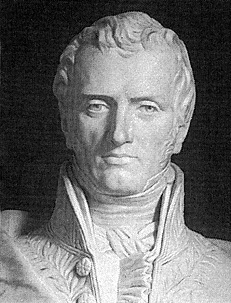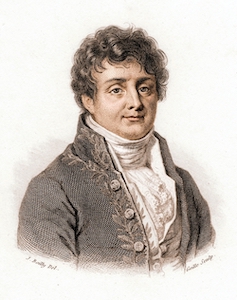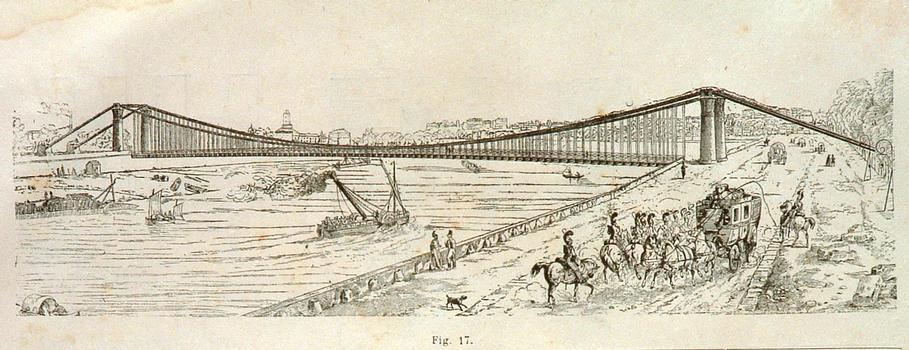
The Navier–Stokes equations are familiar to any engineer modeling fluid flow, but during his lifetime, Claude-Louis Navier was best known as a bridge designer. As a civil engineering professor and textbook author in early-19th-century France, Navier strove to establish mathematical analysis as the foundation of engineering. It may be hard to believe today, but this was a controversial approach to building infrastructure at the time. Eventually, the world would come to accept that engineering should be a synthesis of theory and practice, mediated by mathematical analysis — a concept that Claude-Louis Navier exemplified, both in the successes of his career — and the setbacks.
Claude-Louis Navier: Building Bridges Between the Theoretical and Practical
Claude-Louis Navier was born on February 10, 1785, in Dijon, France.
As noted above, Navier was better known during his lifetime for designing bridges than for his inquiries into fluid dynamics. Bridges were, in a sense, his family business. He was mostly raised by his great-uncle, Émiland Gauthey, a leading civil engineer with the Corps des Ponts et Chaussées, the national department responsible for building France’s bridges and roads.

A sculpture of Claude-Louis Navier (1785–1836). Image in the public domain, via Wikimedia Commons.
Young Navier entered the École Polytechnique in Paris in 1802. Though he wasn’t a star student at first, he made rapid progress under the tutelage of noted mathematician Joseph Fourier. Like Navier, Fourier’s name is forever attached to the valuable mathematical tools he developed, such as the Fourier series and the Fourier transformation.

Joseph Fourier (1768–1830), noted mathematician and teacher of Claude-Louis Navier. Image in the public domain, via Wikimedia Commons.
Navier’s career showed the profound influence of Fourier on his thinking. Even as he followed in his great-uncle Gauthey’s footsteps as a civil engineer and professor at the École Nationale des Ponts et Chaussées, Navier “made mathematical analysis a fundamental tool of the civil engineer and codified the nascent concept of mechanical work for the science of machines.”
Bold Engineering Meets Parisian Politics
In 1824, construction began on a suspension bridge that Navier designed. The Pont des Invalides was intended to cross the River Seine in Paris. As you might expect, Navier incorporated a mathematical analysis of the physics at work in the bridge into his design process.
With private funding and the support of the Corps des Ponts et Chaussées, masonry towers were built on each bank, and cables were strung across the river to support the bridge’s deck. Not long before completion, in 1826, flooding from a broken pipe caused one of the towers to shift and crack, threatening the stability of the entire structure.

The never-completed Pont des Invalides bridge design. Image in the public domain, via Wikimedia Commons.
The Corps des Ponts et Chaussées believed the damage could be repaired and the bridge completed. But the city’s municipal government wanted the structure torn down. In fact, many Parisians opposed the bridge’s construction at that location, as well as its then-radical design. A committee was formed to resolve the issue, which sided with the city and was pointedly critical of Navier’s methods:
In a highly politicized statement, the committee criticized the design for relying too much on mathematics while at the same time praising the superior, nonmathematical achievements of the British.
And so, the unfinished structure was torn down, and Navier would never design another Parisian bridge. (The Pont des Invalides was later redesigned and built in a different spot on the river, where it still stands today.)
History would be kinder to Navier than the committee that literally and figuratively condemned his ambitious work. Even in his own lifetime, Navier’s abilities were recognized through his election to the French Academy of Sciences in 1824 and by becoming chevalier of the Legion of Honour in 1831.
His pioneering theoretical work would be further refined by his successors, most notably Scottish physicist and mathematician Sir George Gabriel Stokes…
Approximating Fluid Flow with the Navier–Stokes Equations
The eponymous Navier–Stokes equations, developed by Stokes after Navier died in 1836, enable us to predict a fluid’s velocity and pressure within a defined space. That space may be a pipe, a vessel, or a container, with varying boundary conditions such as inlets, outlets, and walls. The movement of liquids and gases through any environment can be modeled with the Navier–Stokes equations and partial differential equations, though in practice, there are significant constraints and approximations involved in any fluid flow analysis.
Modern engineering’s devotion to mathematical approximation would have probably pleased Claude-Louis Navier, although it may have shocked some of his contemporaries.
Bridging the Gap Between Centuries
Modern accounts of Navier’s bridge project tend to disagree on how much blame he deserves for its failure, as well as whether the structure should have been repaired rather than replaced. We can assume that Paris eventually forgave Claude-Louis Navier, though. Later in the 19th century, his name was added to an honor roll of French scientists, mathematicians, and engineers inscribed on the Eiffel Tower.

Navier’s name on the Eiffel Tower. Image by Chabe01 — Own work. Licensed under CC BY-SA 4.0, via Wikimedia Commons.
Let’s wish a happy birthday to Claude-Louis Navier!
Further Reading
- Learn more about Claude-Louis Navier, including the disputes around his suspension bridge, from these resources:
- Refer to these COMSOL resources on topics related to Claude-Louis Navier’s work, and that of his mentor, Joseph Fourier:



Comments (0)